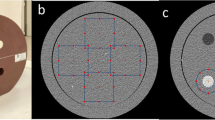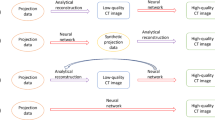Abstract
Purpose
This study aimed to assess the image characteristics of deep-learning-based image processing software (DLIP; FCT PixelShine, FUJIFILM, Tokyo, Japan) and compare it with filtered back projection (FBP), model-based iterative reconstruction (MBIR), and deep-learning-based reconstruction (DLR).
Methods
This phantom study assessed the object-specific spatial resolution (task-based transfer function [TTF]), noise characteristics (noise power spectrum [NPS]), and low-contrast detectability (low-contrast object-specific contrast-to-noise ratio [CNRLO]) at three different output doses (standard: 10 mGy; low: 3.9 mGy; ultralow: 2.0 mGy). The processing strength of DLIPFBP with A1, A4, and A9 was compared with those of FBP, MBIR, and DLR.
Result
The standard dose with high-contrast TTFs of DLIPFBP exceeded that of FBP. Low-contrast TTFs were comparable to or lower than that of FBP. The NPS peak frequency (fP) of DLIPFBP shifts to low spatial frequencies of up to 8.6% at ultralow doses compared to the standard FBP dose. MBIR shifted the most fP compared to FBP—a marked shift of up to 49%. DLIPFBP showed a CNRLO equal to or greater than that of DLR in standard or low doses. In contrast, the CNRLO of the DLIPFBP was equal to or lower than that of the DLR in ultralow doses.
Conclusion
DLIPFBP reduced image noise while maintaining a resolution similar to commercially available MBIR and DLR. The slight spatial frequency shift of fP in DLIPFBP contributed to the noise texture degradation suppression. The NPS suppression in the low spatial frequency range effectively improved the low-contrast detectability.







Similar content being viewed by others
Data availability
The data that support the findings of this study are available from the corresponding author, AU, upon reasonable srequest.
References
Organisation for Economic Co-operation and Development (OECD). [Available from: https://data.oecd.org/healthcare/computed-tomography-ct-exams.htm]. Accessed 2 Aug 2023
Urikura A, Yoshida T, Matsubara K, Nomura K, Hoshino T, Takagi T (2023) Number of computed tomography scanners and regional disparities based on population and medical resources in Japan. Radiol Phys Technol. https://doi.org/10.1007/s12194-023-00725-2. (Epub ahead of print)
Goenka AH, Herts BR, Obuchowski NA, Primak AN, Dong F, Karim W et al (2014) Effect of reduced radiation exposure and iterative reconstruction on detection of low-contrast low-attenuation lesions in an anthropomorphic liver phantom: an 18-reader study. Radiology 272:154–163. https://doi.org/10.1148/radiol.14131928
Jensen CT, Wagner-Bartak NA, Vu LN, Liu X, Raval B, Martinez D et al (2019) Detection of colorectal hepatic metastases is superior at standard radiation dose CT versus reduced dose CT. Radiology 290:400–409. https://doi.org/10.1148/radiol.2018181657
Akai H, Kiryu S, Shibata E, Maeda E, Sato J, Tomizawa N et al (2016) Reducing CT radiation exposure with organ effective modulation: a retrospective clinical study. Eur J Radiol 85:1569–1573. https://doi.org/10.1016/j.ejrad.2016.06.008
Nam JG, Hong JH, Kim DS, Oh J, Goo JM (2021) Deep learning reconstruction for contrast-enhanced CT of the upper abdomen: similar image quality with lower radiation dose in direct comparison with iterative reconstruction. Eur Radiol 31:5533–5543. https://doi.org/10.1007/s00330-021-07712-4
Prakash P, Kalra MK, Kambadakone AK, Pien H, Hsieh J, Blake MA et al (2010) Reducing abdominal CT radiation dose with adaptive statistical iterative reconstruction technique. Investig radiol 45:202–210. https://doi.org/10.1097/RLI.ob013e3181dzfeec
Beister M, Kolditz D, Kalender WA (2012) Iterative reconstruction methods in X-ray CT. Phys Med 28:94–108. https://doi.org/10.1016/j.ejmp.2012.01.003
Desai G, Thabet A, Elias A, Sahani D (2013) Comparative assessment of three image reconstruction techniques for image quality and radiation dose in patients undergoing abdominopelvic multidetector CT examinations. Br J Radiol. https://doi.org/10.1259/bjr.20120161
Stiller W (2018) Basics of iterative reconstruction methods in computed tomography: a vendor-independent overview. Eur J Radiol 109:147–154. https://doi.org/10.1016/j.ejrad.2018.10.025
Mileto A, Guimaraes LS, McCollough CH, Fletcher JG, Yu L (2019) State of the art in abdominal CT: the limits of iterative reconstruction algorithms. Radiology 293:491–503. https://doi.org/10.1148/radiol.2019191422
Ohno Y, Yaguchi A, Okazaki T, Aoyagi K, Yamagata H, Sugihara N et al (2016) Comparative evaluation of newly developed model-based and commercially available hybrid-type iterative reconstruction methods and filter back projection method in terms of accuracy of computer-aided volumetry (CADv) for low-dose CT protocols in phantom study. Eur J Radiol 85:1375–1382. https://doi.org/10.1016/j.ejrad.2016.05.001
Pourjabbar S, Singh S, Kulkarni N, Muse V, Digumarthy SR, Khawaja RD et al (2015) Dose reduction for chest CT: comparison of two iterative reconstruction techniques. Acta Radiol 56:688–695. https://doi.org/10.1177/0284185114537256
Kawashima H, Ichikawa K, Matsubara K, Nagata H, Takata T, Kobayashi S (2019) Quality evaluation of image-based iterative reconstruction for CT: ccomparison with hybrid iterative reconstruction. J Appl Clin Medical Phys 20:199–205. https://doi.org/10.1002/acm2.12597
Watanabe S, Ichikawa K, Kawashima H, Kono Y, Kosaka H, Yamada K et al (2020) Image quality comparison of a nonlinear image-based noise reduction technique with a hybrid-type iterative reconstruction for pediatric computed tomography. Phys Med 76:100–108. https://doi.org/10.1016/j.ejmp.2020.06.015
Tian SF, Liu AL, Liu JH, Liu YJ, Pan JD (2019) Potential value of the PixelShine deep learning algorithm for increasing quality of 70 kVp+ASiR-V reconstruction pelvic arterial phase CT images. Jpn J Radiol 37:186–190. https://doi.org/10.1007/s11604-018-0798-0
Boedeker K (2019) AiCE deep learning reconstruction: bringing the power of ultra-high resolution CT to routine imaging. Canon Medical Systems Corporation. [Available from: https://es.medical.canon/wp-content/uploads/sites/20/2019/11/White-paper-Kirsten-Boedeker.pdf]. Accessed 2 Aug 2023
Hsieh J, Liu E, Nett B, Tang J, Thibault JB, Sahney S (2019) A new era of image reconstruction: TrueFidelity™. White Paper (JB68676XX), GE Healthcare. [Available from: https://www.gehealthcare.com.br/-/jssmedia/040dd213fa89463287155151fdb01922.pdf]. Accessed 2 Aug 2023
McCollough C, Bakalyar DM, Bostani M, Brady S, Boedeker K, Boone JM et al (2014) Use of water equivalent diameter for calculating patient size and size-specific dose estimates [SSDE] in CT: the Report of AAPM Task Group 220. AAPM Rep 2014:6–23
FUJIFILM. FCT PixelShine [Available from: https://asset.fujifilm.com/www/uk/files/2021-05/1f64fbb72811e1afea76c4fbc618bb19/Pixel_Shine.pdf]. Accessed 2 Aug 2023
Richard S, Husarik DB, Yadava G, Murphy SN, Samei E (2012) Towards task-based assessment of CT performance: system and object MTF across different reconstruction algorithms. Med Phys 39:4115–4122. https://doi.org/10.1118/1.4725171
Urikura A, Ichikawa K, Hara T, Nishimaru E, Nakaya Y (2014) Spatial resolution measurement for iterative reconstruction by use of image-averaging techniques in computed tomography. Radiol Phys Technol 7:358–366. https://doi.org/10.1007/s12194-014-0273-2
Ichikawa K CT measure: Japanese Society of CT Technology; [Available from: https://www.jsct-tech.org/en/]. Accessed 2 Aug 2023
Samei E, Bakalyar D, Boedeker KL, Brady S, Fan J, Leng S et al (2019) Performance evaluation of computed tomography systems: summary of AAPM Task Group 233. Med Phys 46:e735–e756. https://doi.org/10.1002/mp.13763
Urikura A, Hara T, Ichikawa K, Nishimaru E, Hoshino T, Yoshida T et al (2016) Objective assessment of low-contrast computed tomography images with iterative reconstruction. Phys Med 32:992–998. https://doi.org/10.1016/j.ejmp.2016.07.003
Hasegawa A, Ichikawa K, Morioka Y, Kawashima H (2022) A tin filter’s dose reduction effect revisited: using the detectability index in low-dose computed tomography for the chest. Phys Med 99:61–67. https://doi.org/10.1016/j.ejmp.2022.05.006
Higaki T, Nakamura Y, Zhou J, Yu Z, Nemoto T, Tatsugami F et al (2020) Deep learning reconstruction at CT: phantom study of the image characteristics. Acad Radiol 27:82–87. https://doi.org/10.1016/j.acra.2019.09.008
Racine D, Becce F, Viry A, Monnin P, Thomsen B, Verdun FR et al (2020) Task-based characterization of a deep learning image reconstruction and comparison with filtered back-projection and a partial model-based iterative reconstruction in abdominal CT: a phantom study. Phys Med 76:28–37. https://doi.org/10.1016/j.ejmp.2020.06.004
Nagayama Y, Oda S, Nakaura T, Tsuji A, Urata J, Furusawa M et al (2018) Radiation dose reduction at pediatric CT: use of low tube voltage and iterative reconstruction. Radiographics 38:1421–1440. https://doi.org/10.1148/rg.2018180041
Acknowledgements
This study was supported as a joint research project by FUJIFILM Corporation. A.U. is currently receiving a grant (JSPS KAKENHI Grant No. 22K15834). The authors are grateful to the radiological diagnosis staff of the National Cancer Center Hospital who supported this study.
Funding
This work was supported by FUJIFILM Corporation as a joint research project. Atsushi Urikura is currently receiving a grant (JSPS KAKENHI Grant No. 22K15834).
Author information
Authors and Affiliations
Contributions
All authors contributed to the study conception and design. Material preparation, data collection, and analysis were performed by SS, AU, and MM. The first draft of the manuscript was written by SS and AU and all authors commented on previous versions of the manuscript. All authors read and approved the final manuscript.
Corresponding author
Ethics declarations
Conflict of interest
Yuji Jibiki and Mami Yamashita are employees of FUJIFILM Corporation. The authors have no relevant financial or nonfinancial interests to disclose.
Ethical approval
This article does not contain any studies with human participants or animals performed by any of the authors.
Additional information
Publisher's Note
Springer Nature remains neutral with regard to jurisdictional claims in published maps and institutional affiliations.
Rights and permissions
Springer Nature or its licensor (e.g. a society or other partner) holds exclusive rights to this article under a publishing agreement with the author(s) or other rightsholder(s); author self-archiving of the accepted manuscript version of this article is solely governed by the terms of such publishing agreement and applicable law.
About this article
Cite this article
Sato, S., Urikura, A., Mimatsu, M. et al. Physical characteristics of deep learning-based image processing software in computed tomography: a phantom study. Phys Eng Sci Med 46, 1713–1721 (2023). https://doi.org/10.1007/s13246-023-01331-7
Received:
Accepted:
Published:
Issue Date:
DOI: https://doi.org/10.1007/s13246-023-01331-7




